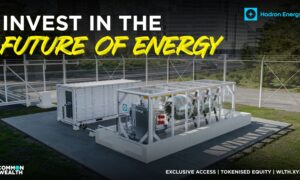Businesses around the globe have understood that achieving Net Zero targets and sustainably and responsibly sourcing energy is vital both to protecting the environment, and to achieving robust and sustainable business. Increasingly, investments and business decisions are made based on issues of energy supply and supply chain sustainability, and nowhere is this more the case than energy usage by governments and businesses in Western Europe.
In November 2022, the European Council introduced reporting requirements for businesses operating in the EU – to report on indirect emissions across their value chain. As a result, businesses across Europe have sought to understand their energy and emissions profiles, and ensure that their businesses are sustainable from the energy they use (scope 2 emissions) – to the value chains of the goods they produce (scope 3 emissions). The profile of scope 2 and scope 3 emissions are fast becoming an important bellwether for the economic and environmental viability for businesses and investors.
Simultaneously, in the United Kingdom, there is an acute energy shortage: After a year of extraordinary increases in the cost of energy in the UK, with price ceilings shattered every few months, Britain’s energy market is rightly worrisome. From an 80% price rise in 2022, to a further 47% in April of 2023, businesses and consumers alike have suffered under spiralling energy prices. Prime Minister Rishi Sunak has taken steps to freeze price rises for consumers, but the Government’s energy price guarantees are by design only stopgap measures, and do not address the deeper insecurity that comes from high electricity prices.
The deeper danger is an economic negative feedback loop in the world’s 5th largest economy and investment destination. The price of energy is baked into every economic output in the country, from manufacturing to services to transport for workers. In May 2023, it was estimated that energy price rises contributed 7% to the UK’s inflation rate; more generally, the high price of electricity leads to a high price of manufacturing, which subsequently raises the cost of goods, resulting in even higher inflation rates – and reduced competitiveness in export markets. Ultimately, this undermines the economic viability of the UK, and reduces its attractiveness as an investment destination.
The UK’s current lacklustre proposals for ameliorating the energy crisis include inadequate and unsustainable options, like opening a new coal mine in Cumbria or importing gas from Middle Eastern countries. The UK already heavily relies on imported natural gas and oil, and in addition to the prices of these commodities skyrocketing due to the War in Ukraine, they are also deeply unsustainable.
Yet there are clear and present options for the UK to achieve increased generation and transmission capacity in a sustainable and responsible way: Two key projects currently in the final stages of development and construction in the UK hold the potential to transform the energy landscape, increase electricity generation and transmission capacity, and lower the price of electricity. These projects, namely the AQUIND Interconnector and Hinkley Point C nuclear power plant, are amongst the most easily and readily deployable options to help the UK quickly enact a programme to turn around its energy situation.
The AQUIND Interconnector is a landmark international project that aims to establish a modern, high-capacity electricity transmission link between the UK and continental Europe. Through the use of High Voltage Direct Current (HVDC) technology, the interconnector allows for efficient power exchange at 2000 megawatt (MW) transmission capacity, enhancing energy connectivity and contributing to a more secure and stable energy supply. The AQUIND Interconnector is projected to supply 17 terawatt hours (TWh) of electricity to the UK per year, equalling 5% of the UK’s 300 TWh current consumption, and by minimising transmission losses, an interconnector such as AQUIND ensures that a greater proportion of generated electricity reaches end-users, thus reducing costs and improving overall energy efficiency. They also contribute to the security and flexibility of the energy grid by responding to fluctuations at times of system stress and high usage. And in the particular case of the AQUIND Interconnector, it aims to reduce carbon emissions materially, both by reducing the UK’s reliance on natural gas, oil and coal power by importing clean nuclear energy from France, and by providing an export route for excess renewable generation in the UK, which fluctuates significantly. Interconnectors also have the benefit of being relatively rapidly deployable; as the AQUIND Interconnector sits at the final stage of its planning permission process, it represents a good option to quickly increase the UK’s electricity transmission capacity in real terms.
The other project of utmost importance for the UK’s energy outlook in the near term is the Hinkley Point C nuclear power plant. It represents a significant stride towards achieving a sustainable, low-carbon future for the UK through home-grown generation. The project’s 3200 MW generation capacity would also see a further 7% of UK energy needs supplied by clean nuclear energy. Hinkley Point C’s advanced nuclear power generation design aims to provide a long-lasting, reliable and clean power supply, driving the country’s transition to a greener energy mix. It, too, has been subject to multi-year delays in approvals and construction, and without Government action to see the project through to completion, there is real fear among investors and the energy sector alike that it may be several years beyond its already-delayed projected completion date in 2028 before the plant comes online.
While the UK Government has a strong public line on achieving Net Zero targets and attracting sustainable business investment, a far more important signal for business in the UK is concrete action that the Government can take to reduce its reliance on unsustainable and inefficient energy generation. Uncomfortably long delays in approving and constructing projects that will seriously contribute to lowering the price of energy – and increasing its renewable energy mix – in the UK frighten and dissuade investors and businesses. Approving AQUIND Interconnector and building Hinkley Point C nuclear power station would be tangible, positive steps to demonstrating the Government’s resolve to take real action on addressing its Net Zero commitments.
Addressing the high cost of electricity in the UK is essential for ensuring energy security and fostering a competitive business environment – but even further for lending the UK much-needed credibility on the issue of renewable and sustainable energy generation and transmission, and more generally on meeting its Net Zero targets. With businesses increasingly required to understand and focus on their energy supply and usage, by prioritising proactive steps towards increasing green and clean energy generation and transmission projects, the UK Government can send a positive signal to business and showcase its genuine commitment to its Net Zero targets. Swift and decisive action will not only boost the country’s economic competitiveness – it will put Britain’s ‘money where its mouth is’ in its drive to become Europe’s leader in renewable energy. In so doing, the UK will once again be able to become an attractive investment destination for sustainability-conscious business, and a viable economic producer and exporter in its own right.

































